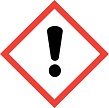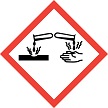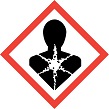GHS Classification Result
GENERAL INFORMATION
REFERENCE INFORMATION
PHYSICAL HAZARDS
HEALTH HAZARDS
ENVIRONMENTAL HAZARDS
NOTE:
GENERAL INFORMATION
| Item | Information |
|---|---|
| CAS RN | 2809-21-4 |
| Chemical Name | 1-Hydroxyethane-1,1-diylbis(phosphonic acid) |
| Substance ID | 24A6139 |
| Classification year (FY) | FY2012 |
| Ministry who conducted the classification | Ministry of Health, Labour and Welfare (MHLW)/Ministry of the Environment (MOE) |
| New/Revised | New |
| Classification result in other fiscal year | |
| Download of Excel format | Excel file |
REFERENCE INFORMATION
| Item | Information |
|---|---|
| Guidance used for the classification (External link) | Physical Hazards and Health Hazards: GHS Classification Guidance by the Japanese Government (July, 2010) Environmental Hazards: UN GHS Document (4th revised edition) |
| UN GHS document (External link) | UN GHS document |
| Definitions/Abbreviations (Excel file) | Definitions/Abbreviations |
| Model Label by MHLW (External link) | MHLW Website (in Japanese Only) |
| Model SDS by MHLW (External link) | MHLW Website (in Japanese Only) |
| OECD/eChemPortal (External link) | eChemPortal |
| Hazard class | Classification |
Pictogram Signal word |
Hazard statement (code) |
Precautionary statement (code) |
Rationale for the classification | |
|---|---|---|---|---|---|---|
| 1 | Explosives | Not applicable |
- |
- | - | There are no chemical groups associated with explosive properties present in the molecule. |
| 2 | Flammable gases (including chemically unstable gases) | Not applicable |
- |
- | - | Solid (GHS definition) |
| 3 | Aerosols | Not applicable |
- |
- | - | Not aerosol products. |
| 4 | Oxidizing gases | Not applicable |
- |
- | - | Solid (GHS definition) |
| 5 | Gases under pressure | Not applicable |
- |
- | - | Solid (GHS definition) |
| 6 | Flammable liquids | Not applicable |
- |
- | - | Solid (GHS definition) |
| 7 | Flammable solids | Classification not possible |
- |
- | - | No data available. |
| 8 | Self-reactive substances and mixtures | Not applicable |
- |
- | - | There are no chemical groups present in the molecule associated with explosive or self-reactive properties. |
| 9 | Pyrophoric liquids | Not applicable |
- |
- | - | Solid (GHS definition) |
| 10 | Pyrophoric solids | Classification not possible |
- |
- | - | No data available. |
| 11 | Self-heating substances and mixtures | Classification not possible |
- |
- | - | Test methods applicable to solid (melting point <= 140 deg C) substances are not available. |
| 12 | Substances and mixtures which, in contact with water, emit flammable gases | Not classified |
- |
- | - | There is a metalloid (P) present in the molecule, but from data: water solubility of 69 w/w% (20 deg C) (Merck (14th, 2006)), it is estimated that it does not react vigorously with water. |
| 13 | Oxidizing liquids | Not applicable |
- |
- | - | Solid (GHS definition) |
| 14 | Oxidizing solids | Classification not possible |
- |
- | - | The substance is an organic compound containing oxygen (but not fluorine or chlorine) which is chemically bonded to the element other than carbon or hydrogen (P). However, the classification is not possible due to no data. |
| 15 | Organic peroxides | Not applicable |
- |
- | - | Organic compounds containing no bivalent -O-O- structure. |
| 16 | Corrosive to metals | Classification not possible |
- |
- | - | Test methods applicable to solid substances are not available. |
| Hazard class | Classification |
Pictogram Signal word |
Hazard statement (code) |
Precautionary statement (code) |
Rationale for the classification | |
|---|---|---|---|---|---|---|
| 1 | Acute toxicity (Oral) | Category 4 |
 Warning |
H302 |
P301+P312
P264 P270 P330 P501 |
An LD50 value of 1,536-2,003 mg/kg for rats (SIAP (2004)) corresponds to Category 4 to "Not classified," and an LD50 value of 1,100 mg/kg for mice (SIAP (2004)) corresponds to Category 4. It was classified in Category 4, which was more hazardous. |
| 1 | Acute toxicity (Dermal) | Not classified |
- |
- | - | It was classified as "Not classified" from a report on an LD50 value of > 6,000 mg/kg for rats (SIAP (2004)). |
| 1 | Acute toxicity (Inhalation: Gases) | Not applicable |
- |
- | - | Solid (GHS definition) |
| 1 | Acute toxicity (Inhalation: Vapours) | Classification not possible |
- |
- | - | No data available. |
| 1 | Acute toxicity (Inhalation: Dusts and mists) | Classification not possible |
- |
- | - | No data available. |
| 2 | Skin corrosion/irritation | Category 1 |
 Danger |
H314 |
P301+P330+P331
P303+P361+P353 P305+P351+P338 P304+P340 P260 P264 P280 P310 P321 P363 P405 P501 |
It was classified in Category 1 because it is described that the pH of the saturated aqueous solution was < 2 (IUCLID (2000)). Besides, it is also reported that it was moderately irritating in a test with rabbits (HERA (2004)). |
| 3 | Serious eye damage/eye irritation | Category 1 |
 Danger |
H318 |
P305+P351+P338
P280 P310 |
It was classified in Category 1 because it is described that the pH of the saturated aqueous solution was < 2 (IUCLID (2000)). Besides, it is also reported that it was moderately irritating in a test with rabbits (HERA (2004)). |
| 4 | Respiratory sensitization | Classification not possible |
- |
- | - | No data available. |
| 4 | Skin sensitization | Classification not possible |
- |
- | - | Data are lacking. Besides, it is described that this substance is not a skin sensitizer (SIAP (2004)), but there are no further descriptions, and the details are unclear. Therefore, it was classified as "Classification not possible." |
| 5 | Germ cell mutagenicity | Classification not possible |
- |
- | - | The classification is not possible due to no in vivo test data. Besides, as for in vitro tests, it is reported that it was negative in both an Ames test and a mouse lymphoma test with L5178Y cells (JECFA (2006)). |
| 6 | Carcinogenicity | Classification not possible |
- |
- | - | No data available. |
| 7 | Reproductive toxicity | Classification not possible |
- |
- | - | In a test by oral administration to pregnant rats during the organogenesis period, no significant differences were observed between treated and control groups in general toxicity in maternal animals, developmental parameters and morphological changes in offspring (HSDB (2003)). And in a test by oral administration to rats from gestational day 15 through the end of gestation and the lactation period, there were changes in parameters such as a decreased number of implantations/litter and decreased pup survival, but they were not dose-dependent, and no significant differences were reported between treated and control groups in other developmental parameters such as pregnancy rate, length of gestation period, and number of litters delivered (HSDB (2003)). However, because of no data on sexual function and fertility, it was classified as "Classification not possible" due to lack of data. |
| 8 | Specific target organ toxicity - Single exposure | Category 2 (systemic toxicity) |
 Warning |
H371 |
P308+P311
P260 P264 P270 P405 P501 |
In an acute oral toxicity test with rats (1,200, 1,506, 1,896 and 2,388 mg/kg, LD50 value: 1,878 mg/kg), the animals showed signs of weakness followed by dyspnea and collapse, and deaths were found at or above 1506 mg/kg (HERA (2004)). Furthermore, in another acute oral toxicity test with rats (948, 1,200, 1,506, 1,896 mg/kg, LD50 value: 1,440 mg/kg), there were signs of decreased appetite and activity, increasing weakness, diarrhea, tremors, and collapse, and deaths occurred at or above 1,200 mg/kg (HERA (2004)). The above was within a dose range corresponding to the guidance values for Category 2, but because it was impossible to specify the target organ, it was classified in Category 2 (systemic toxicity). |
| 9 | Specific target organ toxicity - Repeated exposure | Classification not possible |
- |
- | - | In a 90-day diet administration test with rats (doses: 0, 1,000, 3,000, 10,000 ppm (0, 154-166, 524-545, 1,583-1,724 mg/kg/day)), only slight decreases in body weights and liver weights were observed in the highest dose group, and the NOAEL was reported to be 1,583-1,724 mg/kg/day (HERA (2004)), and in a 90-day diet administration test with dogs (doses: 0, 1,000, 3,000, 10,000 ppm (0, 191-202, 553-554, 1,620-1,746 mg/kg/day)), there were no effects of the administration of this substance, and the NOAEL was reported to be greater than 1,620-1,746 mg/kg/day (HERA (2004)). Because the NOAEL far exceeded the guidance value range in both the 90-day repeated oral administration tests with rats and dogs, it corresponds to "Not classified" in the oral route. However, because effects are unknown in the other routes (inhalation, dermal) due to no data, it was classified as "Classification not possible" for this hazard class. Besides, it is reported that in a test with rats by 14-day or 21-day inhalation exposure to the disodium salt of this substance, laryngitis occurred, and erosion in the mucous membranes, the existence of foreign-body giant cells, deposition of the test substance in the subepithelial connective tissue, etc. were found (IUCLID (2000)). |
| 10 | Aspiration hazard | Classification not possible |
- |
- | - | No data available. |
| Hazard class | Classification |
Pictogram Signal word |
Hazard statement (code) |
Precautionary statement (code) |
Rationale for the classification | |
|---|---|---|---|---|---|---|
| 11 | Hazardous to the aquatic environment (Acute) | Not classified |
- |
- | - | It was classified as "Not classified from 48-hour EC50 = 167 mg/L for crustacea (Daphnia magna) and 96-hour LC50 >= 180 mg/L for fish (SIAP (Conclusions Agreed in SIAM 18, 2004)). |
| 11 | Hazardous to the aquatic environment (Long-term) | Not classified |
- |
- | - | Reliable chronic toxicity data were not obtained. It was classified as "Not classified" because it is not water-insoluble (water solubility: 690000 mg/L, PHYSPROP Database, 2012), and it was classified as "Not classified" in acute toxicity. |
| 12 | Hazardous to the ozone layer | Classification not possible |
- |
- | - | This substance is not listed in the Annexes to the Montreal Protocol. |
NOTE:
|